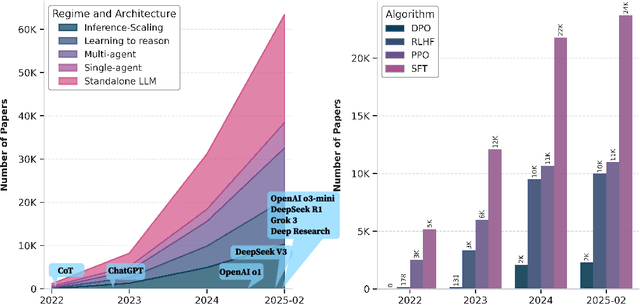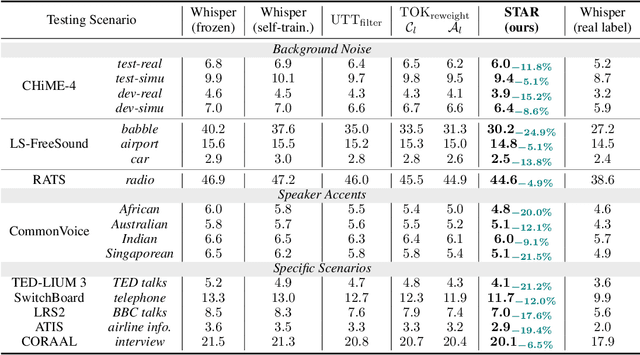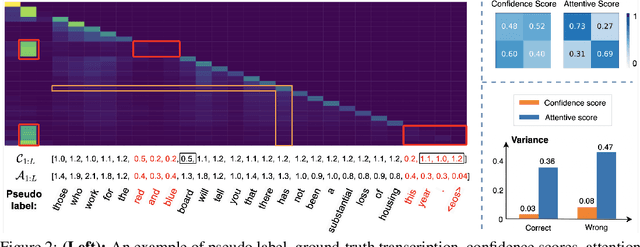Chengwei Qin
Task-Adaptive Parameter-Efficient Fine-Tuning for Weather Foundation Models
Sep 26, 2025Abstract:While recent advances in machine learning have equipped Weather Foundation Models (WFMs) with substantial generalization capabilities across diverse downstream tasks, the escalating computational requirements associated with their expanding scale increasingly hinder practical deployment. Current Parameter-Efficient Fine-Tuning (PEFT) methods, designed for vision or language tasks, fail to address the unique challenges of weather downstream tasks, such as variable heterogeneity, resolution diversity, and spatiotemporal coverage variations, leading to suboptimal performance when applied to WFMs. To bridge this gap, we introduce WeatherPEFT, a novel PEFT framework for WFMs incorporating two synergistic innovations. First, during the forward pass, Task-Adaptive Dynamic Prompting (TADP) dynamically injects the embedding weights within the encoder to the input tokens of the pre-trained backbone via internal and external pattern extraction, enabling context-aware feature recalibration for specific downstream tasks. Furthermore, during backpropagation, Stochastic Fisher-Guided Adaptive Selection (SFAS) not only leverages Fisher information to identify and update the most task-critical parameters, thereby preserving invariant pre-trained knowledge, but also introduces randomness to stabilize the selection. We demonstrate the effectiveness and efficiency of WeatherPEFT on three downstream tasks, where existing PEFT methods show significant gaps versus Full-Tuning, and WeatherPEFT achieves performance parity with Full-Tuning using fewer trainable parameters. The code of this work will be released.
RIMO: An Easy-to-Evaluate, Hard-to-Solve Olympiad Benchmark for Advanced Mathematical Reasoning
Sep 09, 2025Abstract:As large language models (LLMs) reach high scores on established mathematical benchmarks, such as GSM8K and MATH, the research community has turned to International Mathematical Olympiad (IMO) problems to push the evaluation frontier. However, existing Olympiad-level benchmarks suffer from practical constraints that introduce grading noise and potential bias, such as heterogeneous answer formats requiring model-based judges and a reliance on potentially flawed solutions. We introduce RIMO, a two-track benchmark designed to preserve peak Olympiad difficulty while eliminating this evaluation noise. The first track, RIMO-N, rewrites 335 IMO problems to admit a single, unique integer answer, allowing for deterministic correctness checking. The second track, RIMO-P, features 456 proof problems with expert-checked solutions, which are decomposed into a sequence of sub-problems to evaluate the step-by-step reasoning process via an automated grading system. Our benchmarking of ten frontier LLMs, including GPT-4o and Gemini 2.5 Flash, reveals that while these systems excel on older benchmarks, their performance drops sharply on RIMO. These results highlight a substantial gap between current LLM capabilities and actual Olympiad-level reasoning. By providing a challenging yet easy-to-evaluate suite, RIMO offers a high-resolution yardstick for future research, presenting a clear target for closing the profound reasoning gap our findings expose.
DRQA: Dynamic Reasoning Quota Allocation for Controlling Overthinking in Reasoning Large Language Models
Aug 25, 2025Abstract:Reasoning large language models (RLLMs), such as OpenAI-O3 and DeepSeek-R1, have recently demonstrated remarkable capabilities by performing structured and multi-step reasoning. However, recent studies reveal that RLLMs often suffer from overthinking, i.e., producing unnecessarily lengthy reasoning chains even for simple questions, leading to excessive token consumption and computational inefficiency. Interestingly, we observe that when processing multiple questions in batch mode, RLLMs exhibit more resource-efficient behavior by dynamically compressing reasoning steps for easier problems, due to implicit resource competition. Inspired by this, we propose Dynamic Reasoning Quota Allocation (DRQA), a novel method that transfers the benefits of resource competition from batch processing to single-question inference. Specifically, DRQA leverages batch-generated preference data and reinforcement learning to train the model to allocate reasoning resources adaptively. By encouraging the model to internalize a preference for responses that are both accurate and concise, DRQA enables it to generate concise answers for simple questions while retaining sufficient reasoning depth for more challenging ones. Extensive experiments on a wide range of mathematical and scientific reasoning benchmarks demonstrate that DRQA significantly reduces token usage while maintaining, and in many cases improving, answer accuracy. By effectively mitigating the overthinking problem, DRQA offers a promising direction for more efficient and scalable deployment of RLLMs, and we hope it inspires further exploration into fine-grained control of reasoning behaviors.
Learning Auxiliary Tasks Improves Reference-Free Hallucination Detection in Open-Domain Long-Form Generation
May 18, 2025Abstract:Hallucination, the generation of factually incorrect information, remains a significant challenge for large language models (LLMs), especially in open-domain long-form generation. Existing approaches for detecting hallucination in long-form tasks either focus on limited domains or rely heavily on external fact-checking tools, which may not always be available. In this work, we systematically investigate reference-free hallucination detection in open-domain long-form responses. Our findings reveal that internal states (e.g., model's output probability and entropy) alone are insufficient for reliably (i.e., better than random guessing) distinguishing between factual and hallucinated content. To enhance detection, we explore various existing approaches, including prompting-based methods, probing, and fine-tuning, with fine-tuning proving the most effective. To further improve the accuracy, we introduce a new paradigm, named RATE-FT, that augments fine-tuning with an auxiliary task for the model to jointly learn with the main task of hallucination detection. With extensive experiments and analysis using a variety of model families & datasets, we demonstrate the effectiveness and generalizability of our method, e.g., +3% over general fine-tuning methods on LongFact.
A Survey of Frontiers in LLM Reasoning: Inference Scaling, Learning to Reason, and Agentic Systems
Apr 12, 2025



Abstract:Reasoning is a fundamental cognitive process that enables logical inference, problem-solving, and decision-making. With the rapid advancement of large language models (LLMs), reasoning has emerged as a key capability that distinguishes advanced AI systems from conventional models that empower chatbots. In this survey, we categorize existing methods along two orthogonal dimensions: (1) Regimes, which define the stage at which reasoning is achieved (either at inference time or through dedicated training); and (2) Architectures, which determine the components involved in the reasoning process, distinguishing between standalone LLMs and agentic compound systems that incorporate external tools, and multi-agent collaborations. Within each dimension, we analyze two key perspectives: (1) Input level, which focuses on techniques that construct high-quality prompts that the LLM condition on; and (2) Output level, which methods that refine multiple sampled candidates to enhance reasoning quality. This categorization provides a systematic understanding of the evolving landscape of LLM reasoning, highlighting emerging trends such as the shift from inference-scaling to learning-to-reason (e.g., DeepSeek-R1), and the transition to agentic workflows (e.g., OpenAI Deep Research, Manus Agent). Additionally, we cover a broad spectrum of learning algorithms, from supervised fine-tuning to reinforcement learning such as PPO and GRPO, and the training of reasoners and verifiers. We also examine key designs of agentic workflows, from established patterns like generator-evaluator and LLM debate to recent innovations. ...
Unicorn: Text-Only Data Synthesis for Vision Language Model Training
Mar 28, 2025Abstract:Training vision-language models (VLMs) typically requires large-scale, high-quality image-text pairs, but collecting or synthesizing such data is costly. In contrast, text data is abundant and inexpensive, prompting the question: can high-quality multimodal training data be synthesized purely from text? To tackle this, we propose a cross-integrated three-stage multimodal data synthesis framework, which generates two datasets: Unicorn-1.2M and Unicorn-471K-Instruction. In Stage 1: Diverse Caption Data Synthesis, we construct 1.2M semantically diverse high-quality captions by expanding sparse caption seeds using large language models (LLMs). In Stage 2: Instruction-Tuning Data Generation, we further process 471K captions into multi-turn instruction-tuning tasks to support complex reasoning. Finally, in Stage 3: Modality Representation Transfer, these textual captions representations are transformed into visual representations, resulting in diverse synthetic image representations. This three-stage process enables us to construct Unicorn-1.2M for pretraining and Unicorn-471K-Instruction for instruction-tuning, without relying on real images. By eliminating the dependency on real images while maintaining data quality and diversity, our framework offers a cost-effective and scalable solution for VLMs training. Code is available at https://github.com/Yu-xm/Unicorn.git.
StructTest: Benchmarking LLMs' Reasoning through Compositional Structured Outputs
Dec 23, 2024



Abstract:The rapid development of large language models (LLMs) necessitates robust, unbiased, and scalable methods for evaluating their capabilities. However, human annotations are expensive to scale, model-based evaluations are prone to biases in answer style, while target-answer-based benchmarks are vulnerable to data contamination and cheating. To address these limitations, we propose StructTest, a novel benchmark that evaluates LLMs on their ability to produce compositionally specified structured outputs as an unbiased, cheap-to-run and difficult-to-cheat measure. The evaluation is done deterministically by a rule-based evaluator, which can be easily extended to new tasks. By testing structured outputs across diverse task domains -- including Summarization, Code, HTML and Math -- we demonstrate that StructTest serves as a good proxy for general reasoning abilities, as producing structured outputs often requires internal logical reasoning. We believe that StructTest offers a critical, complementary approach to objective and robust model evaluation.
LLM-Based Multi-Hop Question Answering with Knowledge Graph Integration in Evolving Environments
Aug 28, 2024



Abstract:The rapid obsolescence of information in Large Language Models (LLMs) has driven the development of various techniques to incorporate new facts. However, existing methods for knowledge editing still face difficulties with multi-hop questions that require accurate fact identification and sequential logical reasoning, particularly among numerous fact updates. To tackle these challenges, this paper introduces Graph Memory-based Editing for Large Language Models (GMeLLo), a straitforward and effective method that merges the explicit knowledge representation of Knowledge Graphs (KGs) with the linguistic flexibility of LLMs. Beyond merely leveraging LLMs for question answering, GMeLLo employs these models to convert free-form language into structured queries and fact triples, facilitating seamless interaction with KGs for rapid updates and precise multi-hop reasoning. Our results show that GMeLLo significantly surpasses current state-of-the-art knowledge editing methods in the multi-hop question answering benchmark, MQuAKE, especially in scenarios with extensive knowledge edits.
Self-Taught Recognizer: Toward Unsupervised Adaptation for Speech Foundation Models
May 23, 2024



Abstract:We propose an unsupervised adaptation framework, Self-TAught Recognizer (STAR), which leverages unlabeled data to enhance the robustness of automatic speech recognition (ASR) systems in diverse target domains, such as noise and accents. STAR is developed for prevalent speech foundation models based on Transformer-related architecture with auto-regressive decoding (e.g., Whisper, Canary). Specifically, we propose a novel indicator that empirically integrates step-wise information during decoding to assess the token-level quality of pseudo labels without ground truth, thereby guiding model updates for effective unsupervised adaptation. Experimental results show that STAR achieves an average of 13.5% relative reduction in word error rate across 14 target domains, and it sometimes even approaches the upper-bound performance of supervised adaptation. Surprisingly, we also observe that STAR prevents the adapted model from the common catastrophic forgetting problem without recalling source-domain data. Furthermore, STAR exhibits high data efficiency that only requires less than one-hour unlabeled data, and seamless generality to alternative large speech models and speech translation tasks. Our code aims to open source to the research communities.
Listen Again and Choose the Right Answer: A New Paradigm for Automatic Speech Recognition with Large Language Models
May 16, 2024



Abstract:Recent advances in large language models (LLMs) have promoted generative error correction (GER) for automatic speech recognition (ASR), which aims to predict the ground-truth transcription from the decoded N-best hypotheses. Thanks to the strong language generation ability of LLMs and rich information in the N-best list, GER shows great effectiveness in enhancing ASR results. However, it still suffers from two limitations: 1) LLMs are unaware of the source speech during GER, which may lead to results that are grammatically correct but violate the source speech content, 2) N-best hypotheses usually only vary in a few tokens, making it redundant to send all of them for GER, which could confuse LLM about which tokens to focus on and thus lead to increased miscorrection. In this paper, we propose ClozeGER, a new paradigm for ASR generative error correction. First, we introduce a multimodal LLM (i.e., SpeechGPT) to receive source speech as extra input to improve the fidelity of correction output. Then, we reformat GER as a cloze test with logits calibration to remove the input information redundancy and simplify GER with clear instructions. Experiments show that ClozeGER achieves a new breakthrough over vanilla GER on 9 popular ASR datasets.
 Add to Chrome
Add to Chrome Add to Firefox
Add to Firefox Add to Edge
Add to Edge